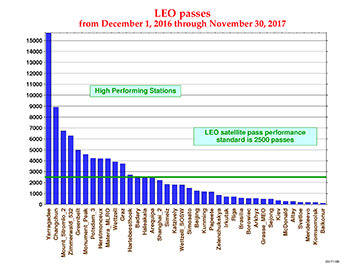Quick Links
- Normal Point Data
- Formats
- Software
- Cite the ILRS
- Revised ILRS station screening process at ILRS Operations Centers (NASA and EDC)
ILRS Data and Products
The ILRS collects, archives, and distributes Satellite Laser Ranging (SLR), Lunar Laser Ranging (LLR), and transponder observation datasets of sufficient accuracy to satisfy the objectives of a wide range of scientific, engineering, and operational applications and experimentation. These data sets are used by the ILRS to generate a number of scientific and operational data products.
ILRS Data: Laser ranging normal points (NPTs) constitute the primary ILRS data product; they are generated following the conclusion of the laser pass and typically transmitted to data centers within hours. Laser ranging normal points are compressed data using all identified signals within a specified time interval. The length of this normal point interval is primarily dependent upon the satellite altitude; lower orbiting satellites have a shorter normal point interval than high-orbit satellites. Full-rate data include all valid satellite returns and are thus larger in volume; these data are routinely provided by most stations in the ILRS network. Full-rate data are useful for both engineering evaluation and scientific applications.
ILRS Products: Products derived from these SLR observations include precise satellite ephemerides, station positions and velocities of sites in the ILRS network, and Earth Orientation Parameters (EOPs, i.e., polar motion and rates, length-of-day).
ILRS Predictions: The laser ranging stations require satellite orbit information in order to point their instrument to the correct location and acquire returns from the retroreflectors. Mission operations centers generate these predicted future orbits from calculated ranging data and radiometric orbits; the files are transmitted to the stations through email or by storing them within data center archives. The Consolidated Prediction Format (CPF) is now used operationally for satellite predictions within the ILRS; CPF provides orbit data that accurately predict positions and ranges for a large variety of targets in tables of X, Y, and Z positions, which can be interpolated for accurate predictions.
ILRS data, products, and predictions are available through two data centers:
- Crustal Dynamics Data Information System (CDDIS) at NASA GSFC, Greenbelt, MD USA
- EUROLAS Data Center (EDC) at DGFI, Munich Germany
Recent News
Read more...
Tom received his B.S. in Engineering Physics and his Ph.D. in Astro-Geophysics from the University of Colorado in 1961 and 1967 respectively. From 1966 to 1968, he served as Chief of the Astronomy Branch at NASA Marshall Space Flight Center and as Project Scientist on the Spacelab Coronagraph. At GSFC, where he moved in 1968, Tom received numerous NASA awards for his pioneering work on Radio Astronomy Explorer 1 and 2 and several generations of Very Long Baseline Interferometry systems. Tom developed the Totally Accurate Clock (TAC), an inexpensive GPS timing receiver that found widespread use in a number of global networks. Tom was named a Fellow of the American Geophysical Union (AGU) in 1991 and a Fellow of the International Association of Geodesy (IAG) in 1999. Tom was also a pioneer in amateur and digital radio; he designed and flew several low cost satellites for relaying amateur radio messages around the globe and is a past president of AMSAT. He was one of only 50 initial inductees into the CQ Amateur Radio Hall of Fame, a list which included such engineering luminaries and inventors as Guglielmo Marconi (radio), Samuel Morse (telegraph), Nikola Tesla (HF generators and radio), and John Bardeen and William Schockley (transistor). Tom retired from GSFC in 2001 but remained active in Amateur Radio activities.
Those of us who worked with Tom during the Crustal Dynamics period remember him as a brilliant mind, a very interesting and sometimes caustic character, but someone who was kind, supportive, and very helpful to those of us around him. We will miss him.
Meetings
Many meetings have been canceled or postponed due to COVID-19. Please see the Meetings page for futher information.





